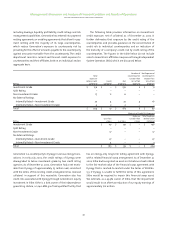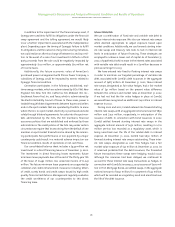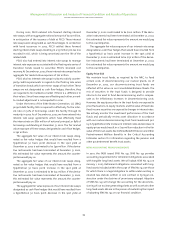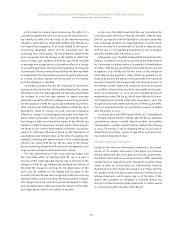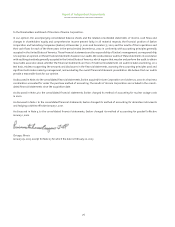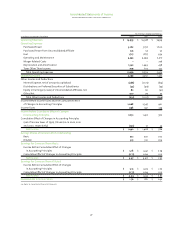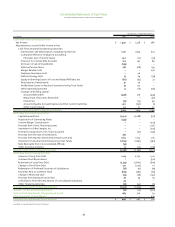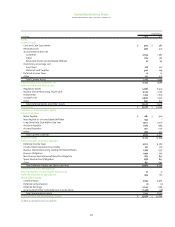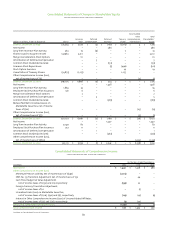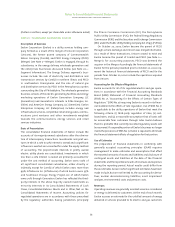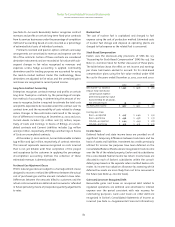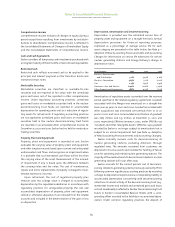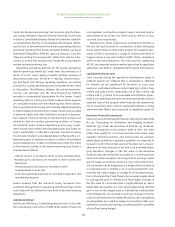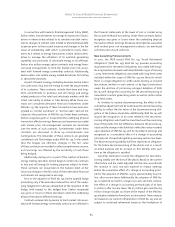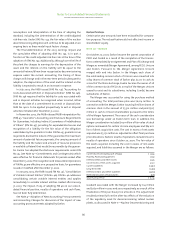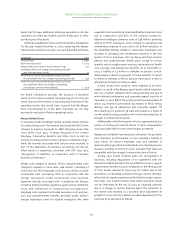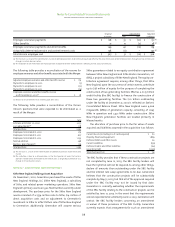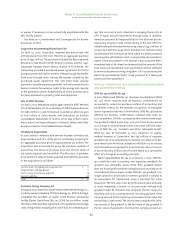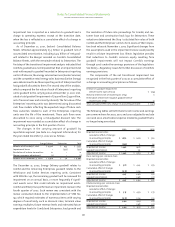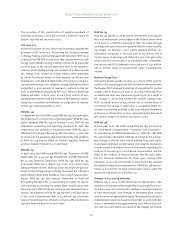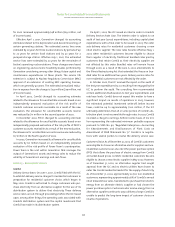ComEd 2002 Annual Report Download - page 84
Download and view the complete annual report
Please find page 84 of the 2002 ComEd annual report below. You can navigate through the pages in the report by either clicking on the pages listed below, or by using the keyword search tool below to find specific information within the annual report.
(see Note 8—Accounts Receivable). Exelon recognizes contract
revenues and profits on certain long-term fixed-price contracts
from its services businesses under the percentage-of-completion
method of accounting based on costs incurred as a percentage
of estimated total costs of individual contracts.
Premiums received and paid on option contracts and swap
arrangements are amortized to revenue and expense over the
life of the contracts. Certain of these contracts are considered
derivative instruments and are recorded at fair value with sub-
sequent changes in fair value recognized as revenues and
expenses unless hedge accounting is applied. Commodity
derivatives used for trading purposes are accounted for using
the mark-to-market method. Under this methodology, these
derivatives are adjusted to fair value, and the unrealized gains
and losses are recognized in current period income.
Long-Term Contract Accounting
Enterprises recognizes contract revenue and profits on certain
long-term fixed-price contracts by the percentage-of-comple-
tion method of accounting. In determining the amount of rev-
enue to recognize,Exelon is required to estimate the total costs
and profits expected to be recorded under the contract over its
contract term, and the recoverability of costs related to change
orders. Changes in these estimates could result in the recogni-
tion of differences in earnings. At December 31, 2002 and 2001,
Current Assets includes $70 million and $77 million, respec-
tively, of Costs and Earnings in Excess of Billings on uncom-
pleted contracts and Current Liabilities includes $44 million
and $56 million, respectively, of Billings and Earnings in Excess
of Costs on uncompleted contracts.
At December 31,2002 and 2001,Accounts Receivable includes
$49 million and $46 million, respectively, of contract retention.
This amount represents revenue recognized on costs incurred
that is not yet billable until final completion of the project
and acceptance by the customer. In applying the percentage-
of-completion accounting method, the collection of these
estimated revenues is deemed probable.
Purchased Gas Adjustment Clause
PECO’s natural gas rates are subject to a fuel adjustment clause
designed to recover or refund the difference between the actual
cost of purchased gas and the amount included in base rates.
Differences between the amounts billed to customers and the
actual costs recoverable are deferred and recovered or refunded
in future periods by means of prospective quarterly adjustments
to rates.
Nuclear Fuel
The cost of nuclear fuel is capitalized and charged to fuel
expense using the unit of production method. Estimated costs
of nuclear fuel storage and disposal at operating plants are
charged to fuel expense as the related fuel is consumed.
Stock-Based Compensation
Exelon uses the disclosure-only provisions of SFAS No. 123,
“Accounting for Stock-Based Compensation” (SFAS No. 123). See
Note 17—Common Stock for further discussion of these plans.
The table below shows the effect on net income and earnings
per share had Exelon elected to account for its stock-based
compensation plans using the fair value method under SFAS
No. 123 for the years ended December 31, 2002, 2001 and 2000:
2002 2001 2000
Net income—as reported $ 1,440 $ 1,428 $ 586
Deduct:Total stock-based
compensation expense
determined under fair value
based method for all awards,
net of income taxes 33 26 25
Pro forma net income $1,407 $ 1,402 $ 561
Earnings per share:
Basic—as reported $4.47 $ 4.46 $ 2.91
Basic—pro forma $ 4.36 $ 4.38 $ 2.77
Diluted—as reported $4.44 $ 4.43 $ 2.87
Diluted—pro forma $ 4.33 $ 4.35 $ 2.75
Income Taxes
Deferred Federal and state income taxes are provided on all
significant temporary differences between book basis and tax
basis of assets and liabilities. Investment tax credits previously
utilized for income tax purposes have been deferred on the
Consolidated Balance Sheets and are recognized in book income
over the life of the related property. Exelon and its subsidiaries
file a consolidated Federal income tax return. Income taxes are
allocated to each of Exelon’s subsidiaries within the consoli-
dated group based on the separate return method. Exelon esti-
mates its income tax valuation allowance by assessing which
deferred tax assets are more likely than not to be recovered in
the future (see Note 14—Income Taxes).
Gains and Losses on Reacquired Debt
Recoverable gains and losses on reacquired debt related to
regulated operations are deferred and amortized to interest
expense over the period consistent with rate recovery for
ratemaking purposes. Gains and losses on other debt are
recognized in Exelon’s Consolidated Statements of Income as
incurred (see Note 6—Supplemental Financial Information).
Notes To Consolidated Financial Statements
exelon corporation and subsidiary companies
82


